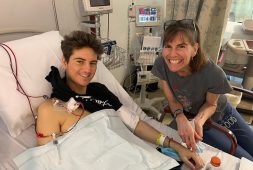
Consuming a diet high in sodium can significantly and adversely impact your blood pressure. Recent research underscores the consensus among experts, advocating a dual approach involving both medication and lifestyle modifications to effectively manage blood pressure levels.
Published on November 11 in JAMA and presented at the American Heart Association Scientific Sessions 2023 in Philadelphia, a groundbreaking study sheds light on the potential for substantial blood pressure reduction through a modest reduction in daily salt intake. Even individuals already on blood pressure medication can experience a noteworthy decrease in blood pressure by simply reducing their daily salt intake by approximately one teaspoon.
This study, considered one of the most extensive investigations into the consequences of sodium reduction on blood pressure, revealed that nearly three out of four participants observed a decline in their blood pressure within just one week of transitioning from a high-sodium to a low-sodium diet. Dr. Norrina Allen, a coauthor of the study, a professor of preventive medicine, and the director of the Institute for Public Health and Medicine at Northwestern Medicine in Chicago, emphasized the rapid and significant impact that dietary changes can have on blood pressure levels.
“The average amount of blood pressure lowering was about 8 millimeters of mercury (mmHg) for systolic blood pressure, which is similar to the effect produced by medications for high blood pressure,” Dr. Allen said.
Only 1 in 4 U.S. Adults With High Blood Pressure Control the Problem
Elevated blood pressure constitutes a significant peril for cardiovascular events such as heart attacks and strokes, contributing substantially to premature fatalities across the globe. The Centers for Disease Control and Prevention (CDC) reported that nearly half of the adult population in the United States, roughly 120 million individuals, grapples with high blood pressure, also known as hypertension.
Dr. Allen highlights the challenging nature of managing blood pressure, even for individuals undergoing medication regimens. Alarmingly, only a mere 25% of adults afflicted with hypertension successfully maintain it within recommended parameters, as per the CDC’s findings.
While a low-sodium, heart-healthy diet is advised for those with high blood pressure, the tangible benefits have not been extensively quantified in recent research. Furthermore, existing studies have often excluded individuals relying on blood pressure-controlling medications, thereby leaving a critical knowledge gap in understanding the comprehensive impact of dietary interventions on this prevalent health concern.
Effects of a Diet With High Sodium vs. Very Little Sodium
The research involved 213 individuals aged between 56 and 65 years. Among the participants, 64 percent were female, with an equal percentage identifying as Black, 33 percent as white, and 1 percent belonging to other races or choosing not to specify.
Participants were randomly assigned to one of two groups. The first group followed a high-sodium diet, consuming 2,200 milligrams (mg) per day in addition to their regular diet. The second group adhered to a low-sodium diet, limiting their intake to a total of 500 mg per day, for a duration of one week. It’s noteworthy that the American Heart Association recommends a sodium intake of under 1,500 mg per day. In the subsequent week, the two groups switched diets.
Prior to each study visit, participants wore blood pressure monitors and collected urine samples over a 24-hour period.
The findings revealed the following:
- Participants following the low-sodium diet experienced a significant reduction in systolic blood pressure, with a decrease of 7 to 8 mmHg compared to those on the high-sodium diet and a 6 mmHg decrease compared to their usual diet.
- A total of 72 percent of participants demonstrated a decrease in systolic blood pressure when adhering to the low-sodium diet as opposed to their usual diet.
- The impact of sodium reduction on blood pressure was consistent across individuals with normal blood pressure, treated high blood pressure, and untreated high blood pressure.
“These results indicate that lowering blood pressure through dietary sodium reduction can be achieved safely and rapidly within one week,” said Deepak K. Gupta, MD, in a press release. He is the study lead author and an associate professor of medicine and the director of the Vanderbilt Translational and Clinical Cardiovascular Research Center at Vanderbilt University Medical Center in Nashville, Tennessee.
The findings here confirm what we know from all previous research: A low-sodium diet can lower blood pressure, said Luke Laffin, MD. He is a cardiologist and the codirector of the center for blood pressure disorders at Cleveland Clinic. “This study shows us that this amount of lowering doesn’t change much, [whether or not] a patient has a diagnosis of hypertension, or what medication (or medications) the patient is taking for their blood pressure,” said Dr. Laffin, who was not part of the study.
Participants Ate Almost Double the Recommended Amount of Sodium
The typical diet observed among the study participants already exhibited an elevated sodium content, averaging approximately 4,500 mg per day. This surpasses the average daily sodium intake of about 3,400 mg for the typical American, which is nearly double the recommended limit of 2,300 mg set by the U.S. Food and Drug Administration (FDA).
Notably, the surplus sodium in our diets is not primarily attributed to discretionary salt use; rather, over 70 percent of our dietary sodium originates from pre-packaged and processed foods such as deli meats, pizza, tacos, and chips. This underscores the significant contribution of commercially prepared items to the excessive sodium levels in our daily nutritional intake.
Control High Blood Pressure Via Changes in Diet and Medications
This evidence reinforced the how important reductions in dietary sodium intake can help control blood pressure, even in those who are already on medications for hypertension, said Gupta. “Just as any physical activity is better than none for most people, any sodium reduction from the current usual diet is likely better than none,” he added.
People with high blood pressure shouldn’t view those blood pressure lowering medications and lifestyle changes as an either/or options, Laffin advised. “Most people need a combination, with a low sodium diet being a cornerstone of lifestyle modification.”
Addressing chronic diseases that play a role in the onset of heart disease, such as hypertension, diabetes, high cholesterol, and obesity, should never involve choosing between prevention and treatment, according to him.
“Lifestyle modification should be a given and the ‘base of the pyramid,’ so to speak. If goals are not reached with lifestyle, then we add medications. I hope this study re-emphasizes this to the population. Unfortunately, many physicians don’t have enough time to discuss both medications and lifestyle with patients, so patients are left to think it’s one or the other, either lifestyle or medications,” Laffin said.
Experts Weigh In On Lower Sodium Intake
A low-sodium diet is the number-one lifestyle change that Dr. Laffin focused on when first meeting a patient suffering from high blood pressure. “This study illustrates why I do this. Patients see blood pressure lowering within a day or two. The same is not true of things like exercise or weight loss; they take time,” he said.
Adopting a low-sodium diet may seem straightforward in the short term, but maintaining such dietary changes over an extended period poses greater challenges, according to Laffin.
To embark on this journey, individuals are encouraged to begin by assessing their sodium intake, achieved through scrutinizing food labels and conducting online research, as recommended by Laffin.
Dr. Allen advocates actively seeking out low- or lower-sodium alternatives for the foods one regularly consumes. When comparing various food products, attention to sodium content on labels is crucial.
Setting a target, Laffin advises aiming for a daily sodium intake of less than 2,300 mg (equivalent to one level teaspoon), with an ideal goal of consuming less than 1,500 mg daily. This approach provides a practical and quantifiable framework for individuals seeking to manage and reduce their sodium consumption in the long run.
But beware: Hidden sodium can be found everywhere, he cautioned. “Bread, salad dressings, and cheese are foods we don’t think of as having a lot of salt, but that actually do.”
Allen suggested that adopting a plant-based diet abundant in fresh fruits and vegetables, while steering clear of heavily processed foods, is another effective method for lowering sodium intake.



